Phanteks Enthoo Evolv ATX Case Review
Pros
Cons
Rating
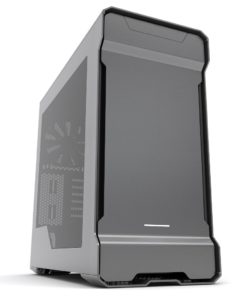
Introduction
Here at The Tech Buyer’s Guru, we really like reviewing cases. In fact, we’ve reviewed more cases than any other PC component, and that’s saying something, because to review a case, you actually have to build a whole new system! So it is with great pleasure that we take a look at our very first Phanteks case, the Enthoo Evolv ATX. Phanteks is a relatively-new manufacturer in the PC space, but it clearly has lofty goals. It started out producing high-end, and only high-end, CPU coolers, and then moved into PC cases, an area ripe for innovation.
And that’s what the Evolv ATX delivers, along with a nice helping of style. Is this the top-performing case ever? No, it’s not, but we think case “performance” has received a bit too much attention in recent years, at the expense of aesthetic design, ease of use, and yes, innovation. Sure, a case with large amount of airflow will “perform” better than one with less airflow, but with most cases now offering sufficient airflow to cool today’s components, Phanteks has gone in another direction with the Evolv ATX, and in case we haven’t made it clear yet, we absolutely love it!
Description and Features
There are in fact three models of the Evolv ATX, the standard matte black model, the Galaxy Silver model, and the Anthracite Grey model we tested. As you might have guessed, they only differ in color, with each appealing to a different segment of the market, while also highlighting the innate beauty of the aluminum panels used to clad the Evolv ATX. You want shiny red, white, or blue? You’re not going to find that here, as unpainted aluminum is never going to be that color. We think Phanteks has made the right decision, going with a high-class finish to complement the high-cost materials being used.
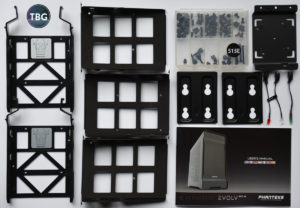
Right off the bat, we were amazed at Phanteks’ attention to detail in packaging the Evolv ATX. All fasteners were pre-sorted into a handy storage case, and the manual provided an excellent guide to all of the modular components that make up the case. That includes three 3.5″ drive sleds, two 2.5″ drive sleds, and a reservoir mount (for ultra-high end custom liquid cooling setups). Phanteks even included three alternative front LEDs, in case the pre-installed white LED doesn’t match your system’s color scheme.
The hard drive trays, seen to the far left in the photo, deserve special mention. These are the very first fully-modular individual sleds we’ve seen in a PC case, and unless Phanteks has patented the design, they surely won’t be the last. Removable drive cages are nothing new, but they’re clunky and restrict airflow when in use, even if just one hard drive is mounted. These individual sleds are the future of PC case design, allowing you to only use the number of sleds you need, and more importantly, taking up no more space than the hard drives themselves. That means airflow is optimized, whether you’re using hard drives or not.
We should also note that there are two fixed sleds available in the lower-front corner of the case, so you’ll probably want to use those first and only employ the modular sleds if you have more drives than will fit “below decks.” That keeps things nice and tidy up top!
To put the case to the test, we loaded it up with the following components:
- CPU: Intel Core i7-6700K
- Motherboard: Asus Z170-A (thanks to Newegg and Asus for providing this review sample)
- Memory: G.Skill 2x8GB Ripjaws 4 DDR4-3000
- Video Card: EVGA GeForce GTX 980 SC 4GB
- Solid-State Drive #1: Samsung 850 Evo 500GB M.2
- Solid-State Drive #2: Crucial MX200 1TB
- Power Supply: EVGA Supernova 850 GS
- CPU Cooler: Noctua NH-U14S (thanks to Noctua for providing this review sample)
- Operating System: Windows 10 Home Download
Note that the Core i5-6700K is cooled by one of the best air coolers on the market, the Noctua NH-U14S, rivaled only by Phanteks’ own offerings. While Phanteks has incorporated a pull-out radiator tray at the top of the case (another PC design first!), it doesn’t market liquid coolers itself, so it surely intended this case to work well with high-end air coolers as well. We decided that was the configuration we’d go with, as we think it’s the best option for a high-end system designed to be powerful yet quiet.
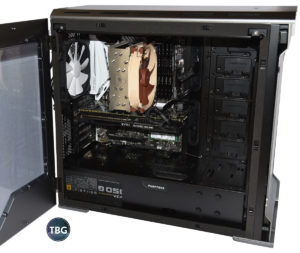
As can be seen above, the Evolv ATX looks fantastic once built up, and the hinged side panels and foam padding around the entirety of the interior door frame really make it feel like a premium design. Handling the the Evolv ATX provides the same satisfying feel as closing the door on a fine German motorcar!
So let’s go ahead and step inside that open door to see what it’s like to build up a system with the Phanteks Evolv ATX!
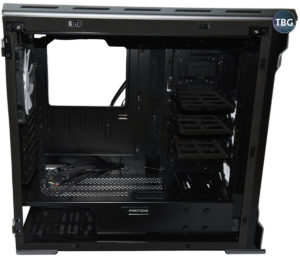
Assembly
As suggested on the previous page, Phanteks has really made ease-of-use a top priority with the Evolv ATX. In the photo here, you can see the interior of the case with the three modular drive sleds installed. Being ultra-low profile and lined with foam padding, they barely impact airflow, while keeping drive chatter to a minimum. And Phanteks includes handy pop-out panels to route the cables through (the panels have been left in place in this instance).
Also contributing to the clean lines of the interior is the non-removable power supply shroud, which covers up most of the cables and also houses two 3.5″ drive sleds. Now, this shroud comes with its own set of drawbacks, as it does in every case we’ve tested with such a design (we believe NZXT was the first to market a case with this feature, but it’s becoming de rigueur for modern cases at this point!). Mounting a power supply requires quite a bit of patience and dexterity, and we pity the poor souls who decide to connect the power cables to their modular power supply (you are using a modular unit, right?!?) after affixing the PSU in place. At least Phanteks has provided an easily-removable fan filter at the bottom of the case, all the better to keep your PSU free of dust and debris if you choose to mount it with the fan pointing down. Perforations in the PSU shroud allow you to mount it face up if that’s your preference (as it should be if you’ll be standing the PC on deep-pile carpet).
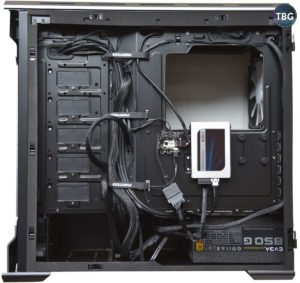
Once we pop the side panel off its heavy-duty hinges, we can get an unobstructed view behind the motherboard. Here you can see the excellent centrally-located cable management channel, as well as the pre-installed PWM fan controller. Strangely, in a rare instance of poor quality control, Phanteks pre-installed the three hook-and-loop straps upside-down, and we didn’t bother to fix them for this build. You can also see one of the “drop ‘n lock” SSD trays in use, which is another fantastic innovation. You screw the drive to the sled, and then just slide it into place, where rubber grommets secure it. Awesome! Phanteks includes a similar drop ‘n lock mount on the front of the PSU shroud, in order to better show off your prized solid-state drive, but using this mount will necessitate some fairly gnarly cable runs, and we think most users will just opt to hide their SSDs behind the motherboard tray.
We need to note one drawback to the included PWM fan controller. You see, it requires a very special connection, as detailed in the Phanteks manual: it must be connected to the CPU_Fan header on the motherboard. No, it will not work with the CPU_OPT header or any other header on the board, as Phanteks indicates that only a “true” PWM signal can control it, and apparently only the CPU_Fan header provides this. As a result, when using the fan controller, your actual CPU fan will need to be connected to a different header, and if you’re using a liquid cooler, you’ll have to connect your pump to yet another header. We really like what Phanteks is trying to do here (fully automate the cooling of the case, going well beyond the typical 3-speed control switch), but in the hands of true PC tweakers, it will probably go unused. The fact that it can only read one RPM signal further complicates matters, as combining different fans on the single controller will lead to uneven fans speeds and a lack of monitoring capability. If you decide that despite the drawbacks you’d still like to use it, don’t forget that it also requires a SATA power cable to run the fans. We applaud Phanteks for pushing innovation in all aspects of case design, and we think most users will really appreciate the inclusion of the fan controller here.
We’ve included the photo below for two reasons: to highlight the USB ports, audio ports, and reset switch hidden behind a classy swinging door, and to show off the unique design of the Evolv’s front fascia, which you just won’t see on competing cases. Straight lines combine with softly-contoured surfaces to create a case that truly stands out from the pack.
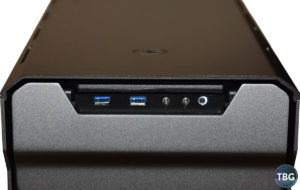
Performance
Rather than provide numerical data to quantify the performance of the Evolv ATX, we’re going to give you our subjective impressions. That’s partly because providing comparison data requires using the same components in every case review, and we’d rather test new cases with new gear, because that’s what they’re designed to use. Want test data for cases filled to the brim with six loud, spinning hard drives? You’ll have to look somewhere else. That’s not how we test our cases, because most users simply aren’t running that kind of system in a modern case. This system was built up with two solid-state drives, a silent Noctua CPU cooler, and a semi-passive power supply. It’s quiet, and thoroughly modern.
But the Phanteks Evolv is not the quietest case around, and that’s partly due to its aluminum cladding. Aluminum is a beautiful, high-quality material, but sound-deadening is not one of its strong suits. Anyone familiar with the evolution of bicycle design will know that at a certain point, aluminum took over from steel as the latest and greatest frame material. It was much lighter, and could be formed into cool-looking fat tubes with ultra-thin walls. But aluminum has some nasty properties when it comes to cycling, including an ultra-harsh ride and the ability to amplify the sound of every little divet in the road. Well, the Evolv ATX is similar, in a way. We could actually hear the resonance of voices at certain volumes and pitches, and this was when the PC was shut off! So, yes, if you’re particularly unlucky, you might find the Evolv amplifying some of the noises in your PC.
Cutting in the opposite direction are the solid front and top panels (the latter a rare sight these days given the performance obsession), which use low-profile side-mounted vents to provide airflow. Also playing a role are the three pre-installed Phanteks PH-F140SP 140mm Fans, which when working in tandem with the pre-wired multi-channel PWM fan controller, provide a near-silent computing experience. Fill your system with equally high-quality gear, and you’ll have a very pleasant computing experience, and you’ll forget all about our bicycle analogy!
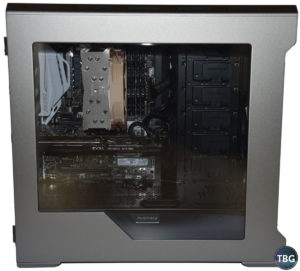
In this last photo, you can see Evolv ATX’s sleek exterior lines and clean interior. It’s a true showcase for a high-end PC build, perhaps even a work of art, and it’s certainly something you’ll want to show off rather than hide away under your desk!
Conclusion
Is this the ideal case for the typical gamer looking for maximum bang-for-the-buck? Absolutely not, and in fact at a retail price of $180, it’s definitely at the very high end of high-end. But as we suggested earlier in this article, we think case performance has been over-emphasized during the past few years, to the detriment of case design. In an era long forgotten in PC circles, Lian-Li was the most coveted brand when it came to computer cases. That’s because of the high build-quality, beautiful craftsmanship, and innovative interior design on display in every Lian-Li case. Today, Lian-Li is an also-ran in the PC business, and that’s probably because it just couldn’t keep up with the times in regard to performance.
Well, Phanteks is bringing cool back to PC cases, in more ways than one. Combining a sleek exterior, ultra-quiet fans, and a high airflow interior design, it balances performance with aesthetics and ease-of-use to give users a truly premium experience. If you want the best performance-per-dollar in a PC case, you won’t find it here, but if you want the best-built, best-looking, and most innovative case on the market at any price, you won’t be disappointed in the Evolv ATX.
As of our publication date, the Phanteks Evolv ATX is available for $179.99 in Anthracite Grey, which we’ve profiled here, as well as in black or silver. If you’d like to build your own PC using the Phanteks Evolv ATX, check out our Do-it-Yourself PC Buyer’s Guides for plenty of component options!

